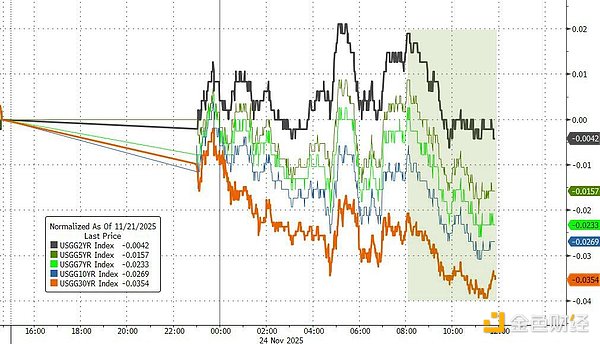Ye Zhen, Wall Street Insights
Several key allies of Federal Reserve Chairman Jerome Powell have recently spoken out in support of another interest rate cut in December, arguing that the risks facing the labor market outweigh those of inflation. This series of statements has rapidly fueled market expectations for further easing by the Fed.
The latest statements come from San Francisco Fed President Mary Daly and Fed Governor Christopher Waller. Daly warned on Monday that the labor market faces the risk of a "non-linear" deterioration, while Waller also publicly supported a December rate cut. Their views echo the dovish stance of New York Fed President John Williams last week, who emphasized the need to avoid bringing "unnecessary risks" to the job market.
The market reacted quickly to this.
**Traders in the interest rate swap market now estimate that the probability of a 25-basis-point rate cut by the Federal Reserve at its December meeting has surged to 80% from about 40% a week ago.** U.S. Treasuries rose for the third consecutive trading day, with the yield on the more policy-sensitive two-year Treasury note falling sharply over the past two trading days, while the yield on the ten-year Treasury note fell to its lowest point this month. The complexity of this decision-making prospect lies in the fact that, due to data release delays caused by the government shutdown, the Fed will not be able to see the crucial October and November jobs reports when it meets on December 10. This forces officials to make judgments with incomplete information, increasing the uncertainty of decision-making. Powell's allies speak out in quick succession, focusing on labor market risks. Several of the most influential officials within the Federal Reserve have shifted the focus of policy debate to the labor market. San Francisco Fed President Mary Daly, in a media interview, clearly stated her support for interest rate cuts because managing a sudden deterioration in the labor market is more difficult than dealing with a rebound in inflation. She warned that the labor market has become "very fragile" and faces the risk of "non-linear changes." It is worth noting that, according to Nick Timiraos of "The New Fed's Newsletter," Daly's public views rarely deviate from Powell's position. Daly's views echo the statements made last week by New York Fed President John Williams. As the third-ranking official at the Federal Reserve, Williams stated last Friday that downside risks to employment have increased as the labor market cools, while upside risks to inflation have eased, thus the Fed still has room for further rate cuts "in the near term." Similarly, Fed Governor Christopher Waller also expressed support for a rate cut in December and a more flexible policy starting in 2026. These officials believe that although inflation is still hovering near 3%, above the 2% target, cost pressures from tariffs are more moderate than expected. Williams pointed out that there is no evidence that tariffs have caused secondary effects or other price spillovers. Therefore, preventing a sharp weakening of the labor market has become a priority. Internal divisions within the committee are becoming more pronounced, making the December decision a "test of judgment." Despite increasingly dovish voices, significant divisions remain within the Federal Reserve Committee. Boston Fed President Susan Collins expressed a more cautious view. She believes the current "moderately tight" policy stance remains appropriate, as resilient demand is likely to continue to exert upward pressure on inflation. She indicated she will remain cautious at the next meeting. Regarding the differing opinions within the Fed, Daly believes this reflects real-world uncertainty rather than "groupthink." She described next month's decision as a "test of judgment," weighing the risks of inaction against the risks of action. She stated that she believes the risk of action (cutting rates) is lower than the risk of inaction. When asked whether cutting rates too early would limit future policy space, Daly directly responded that the Fed should not be constrained by this. She emphasized that the Fed should retain the option to either cut or raise rates further in the future. Against this backdrop, Chairman Powell will play a key role in reconciling internal differences at the December 9-10 meeting. The market reacted swiftly, with bets on a rate cut intensifying. Driven by dovish comments from Federal Reserve officials, financial markets quickly repriced the policy path. According to Bloomberg, overnight index swap (OIS) rates related to the December meeting fell sharply, with the market now pricing in an 80% probability of a 25 basis point rate cut. The US Treasury market reacted positively. The benchmark 10-year Treasury yield fell as much as 3 basis points to 4.03%, a new low for the month. Andrew Brenner, vice president of Natalliance Securities, wrote in a report that despite the absence of key employment data, "investors were comforted by the fact that senior Fed members still hope to ease policy in December."

Besides expectations of interest rate cuts, some technical factors have also provided support for the bond market. According to Bloomberg, the market expects Friday's monthly index rebalancing to drive large funds to buy long-term bonds. Meanwhile, the $69 billion two-year Treasury auction held on Monday saw strong demand, with a bid-to-cover ratio of the highest in three months.
John Canavan, chief analyst at Oxford Economics, noted that "the improved tone of the front-end yield curve over the past few trading days" helped the auction proceed smoothly. This week will also see the auction of $70 billion in five-year and $44 billion in seven-year Treasury bonds.
 Alex
Alex
 Alex
Alex Weiliang
Weiliang Alex
Alex Miyuki
Miyuki Joy
Joy Weatherly
Weatherly Anais
Anais Anais
Anais Weatherly
Weatherly Alex
Alex